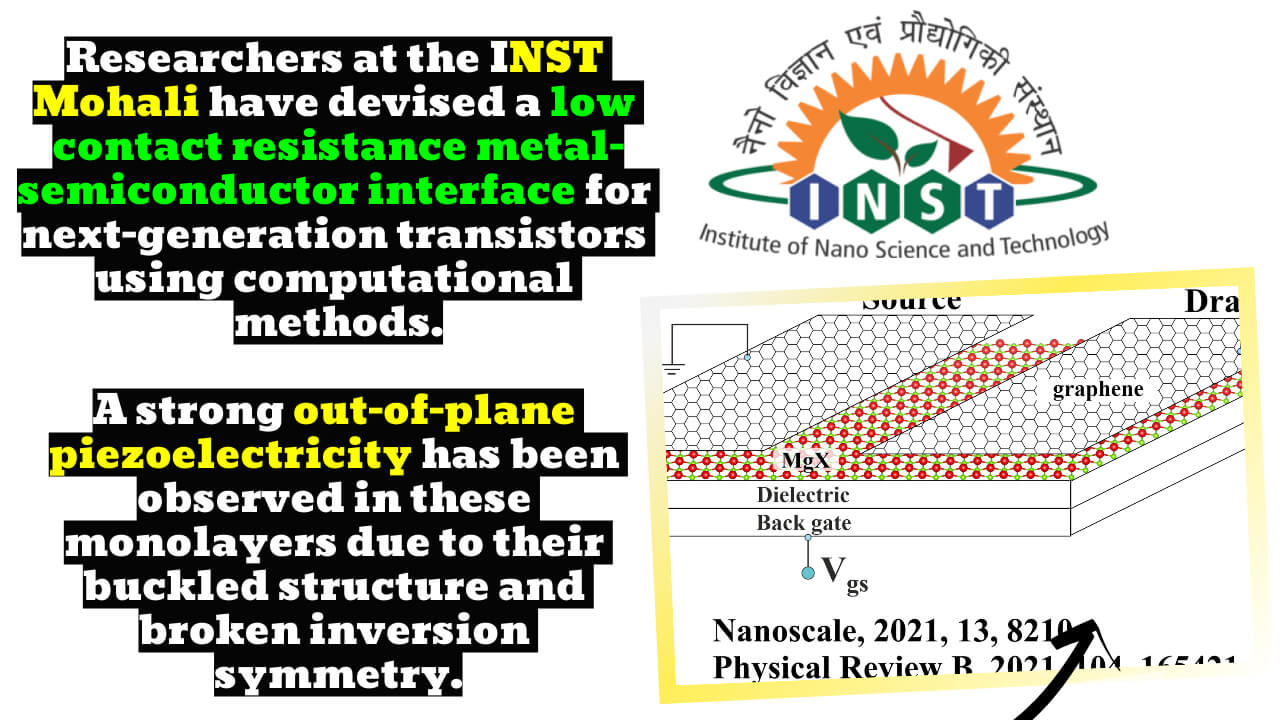For the next generation of transistors, researchers have made a metal-semiconductor interface with 2D monolayers with low contact resistance. This can improve the performance of the devices.
India’s Indian Institute of Nanoscience and Technology has developed a new 2D semiconducting monolayer. Graphene with a broken inversion symmetry has led to a rise in piezoelectricity that comes from outside the plane. These two-dimensional monolayers can be used in electronic devices because they react to electric fields applied from the top. This project hopes to make a big difference in the field of spintronics.
Key Highlight:
- Researchers have devised a computationally low contact resistance metal-semiconductor interface using 2D monolayers for next-generation transistors.
- The reaction of these new 2D monolayers to vertical external electric fields can be used to store information in electronic devices.
- Due to the buckled structure and broken inversion symmetry, these monolayers have strong out-of-plane piezoelectricity, which can generate piezo potential by applying vertical strain.
- The piezo potential can control current flow, making MgTe monolayer devices self-powered.
- They studied reduced contact resistance between semimetal graphene and MgX with Prof. Abir De Sarkar & Manish Kumar Mohanta & Anu Arora. They found perfect non-resistive contact between graphene and MgS, a rare and desired condition for charge transport.
A low contact resistance metal-semiconductor interface with 2D monolayers has been designed for next-generation transistors by computer. This can improve the performance of the devices.
There is a lot of interest in materials in the two-dimensional (2D) world after discovering graphene, a flat monolayer of carbon arranged in a honeycomb lattice of two-dimensional (2D) honeycomb cells. When graphene is made, it doesn’t have any resistance. This is a big problem when making electronics and switching devices. When it is turned on, it can’t turn itself off. 2D semiconductors have been making their way into the world over time because graphene has a lot of limitations.
At the 2D level, new properties aren’t found in their bulk counterparts. It has a charge and a spin. Studying the electron’s spin and magnetic moment on a nanoscale has been possible because of spin-orbit coupling (SOC) and broken inversion symmetry. When a particle’s spin interacts with its motion, this is called spin-orbit coupling (SOC) or broken inversion symmetry (spintronics). People who want to use atomically thin spin field-effect transistors need a strong SOC.
Device performance has been boosted thanks to changes in the electronic properties of the materials. This has made it easier to cut down on the resistance between metal and semiconductors in electronics, making devices run better. They could change their properties by having a small electric field or putting some strain on their surface.
New 2D semiconducting monolayers (MgX X=S, Se, Te) have been suggested by scientists at the Indian Institute of Nanoscience and Technology (INST), which is a department of the Department of Science and Technology (DST). These new monolayers have a lot of charge carriers moving around.
The monolayers that have been proposed are unique because they combine the properties of flexibility, spintronics, and piezoelectrics to make them desirable for self-powered nanoelectronics in the future.
They can be used in electronics to store information because they react to vertical electric fields. These monolayers have a buckled structure with a broken inversion symmetry, which has led to high piezoelectricity that is out of the plane. This can be used to make piezopotentials by applying vertical strain. The piezo potential can control the flow of electricity, making MgTe monolayer-based devices self-powered. This research, which was published in the journal Nanoscale, predicts big changes in spintronics and self-powered electronics through the use of the proposed 2D monolayers.
Prof. Abir De Sarkar and his Ph.D. students, Manish Kumar Mohanta and Anu Arora studied low contact resistance between graphene and MgX in a separate study published in Phys. Rev. B, which you can read about here. Graphene and MgS have made a perfect, non-resistive contact at the point where they meet. This is a rare and very important condition for smooth charge flow across the channel. The electric contact properties can be changed by applying vertical strain and an electric field. This work tries to solve some basic problems in pristine graphenes, like opening the bandgap in a non-invasive way, changing the concentration of charge carriers, and making contacts that depend on how many layers are on top of each other. This work can be used to make graphene-based electronic and spintronic devices that work.
The computational findings are expected to make experimentalists want to make futuristic electronic devices, like piezofield effect transistors, that can do what they want.
Publications
https://pubs.rsc.org/en/content/articlelanding/2021/nr/d1nr00149c
https://journals.aps.org/prb/abstract/10.1103/PhysRevB.104.165421





[…] Researchers at the INST Mohali have devised a low contact resistance interface… […]